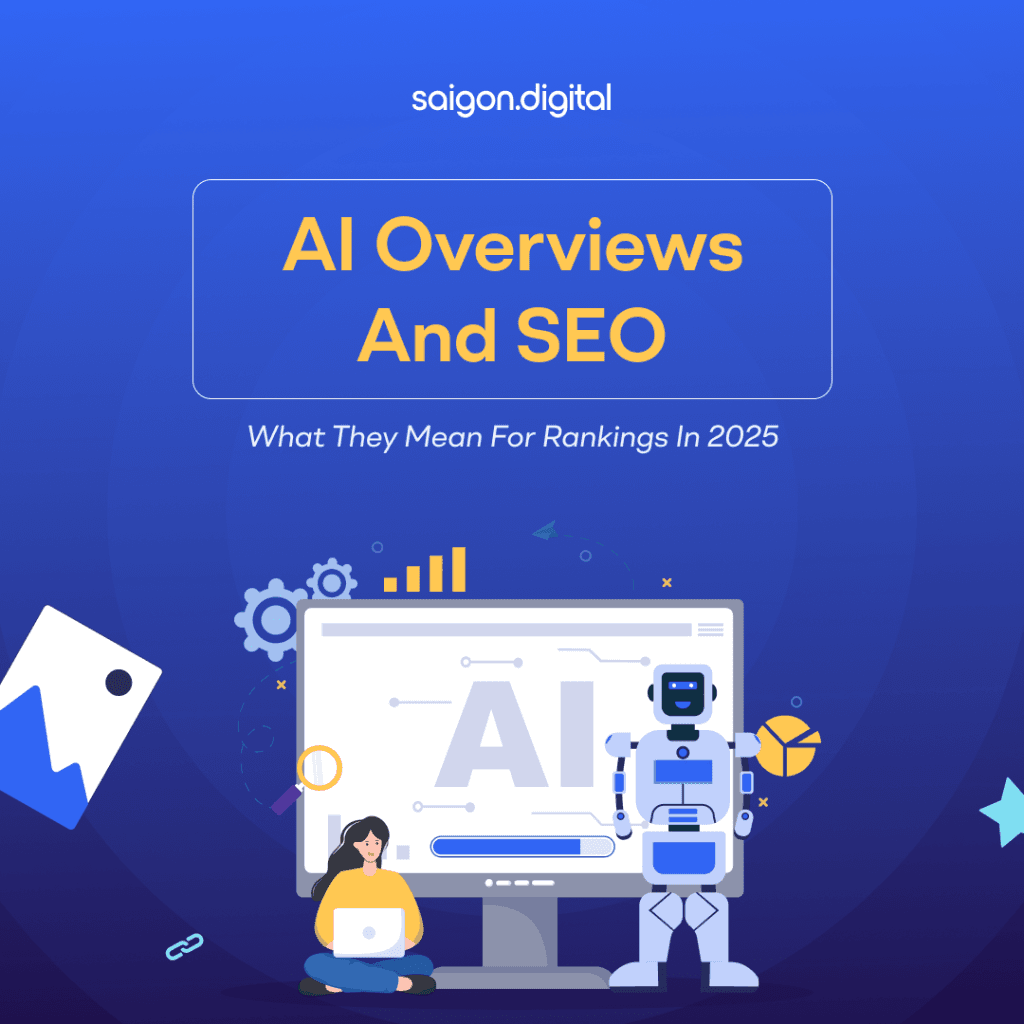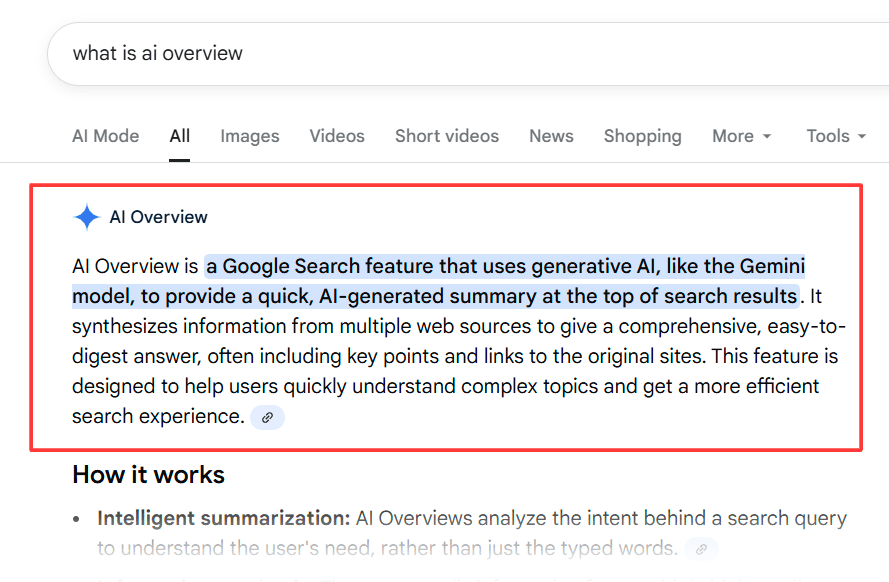
What Are AI Overviews?
AI overviews are one of the main SEO trends of 2025. In essence, they are concise, AI-generated summaries that appear at the top of Google’s search results for certain queries. These snippets are powered by generative AI models, which pull information from a variety of sources to provide quick, direct answers. In the case of Google, the top position of its search results page takes answers from Gemini, Google’s own AI model. You can think of these AI overviews as the evolution of featured snippets. But instead of quoting a single webpage, Google AI overviews blend content from multiple sources into one summarised, conversational response. They're designed to help users find what they're looking for without needing to click through multiple links. Example: Let’s say someone decides to search this query: “how to reduce energy bills at home”. Rather than showing a list of 10 blue links or a traditional featured snippet, Google might now generate an AI overview such as: “To reduce your energy bills, consider switching to energy-efficient appliances, improving insulation, sealing windows, and using programmable thermostats. Solar panels may also offer long-term savings.” This response could be generated by pulling from energy blogs, government websites, and product guides, all without linking directly to a single source.
The Shift from Traditional Search to Generative Overviews
The introduction of generative overviews marks a fundamental change in how people discover information online. In the past, search engines pointed users to websites. Now, increasingly, they are trying to answer questions themselves. This shift raises important questions for anyone involved in SEO:- If Google gives the answer directly, will people still visit my website?
- How do I make sure my content is included in these AI-generated summaries?
- What does “ranking” even mean in this new search environment?
How Google AI Overviews Work
Google’s generative AI models analyse large volumes of indexed content and identify the most relevant, trustworthy, and authoritative sources related to a query. They then summarise this information using natural language generation, with the goal of creating a coherent and helpful response. Where possible, the AI includes citations, typically linking to websites whose content informs the answer. While the precise mechanics of the algorithm are proprietary, several key factors influence whether your content gets cited:- Relevance: How closely your content matches the user’s query intent.
- Topical authority: Whether your site is known for producing high-quality content on the topic.
- Clarity and structure: How well your content is written and organised for AI interpretation.
- Factual accuracy: The reliability of the information you provide.
Will AI Overviews Reduce Organic Traffic?
In some cases, yes. Especially for simple queries like definitions or basic facts. But they can also increase traffic if your content is cited and linked within the overview. Early studies suggest that being featured in an AI overview can actually outperform traditional rankings in terms of click-through rate, especially if users want deeper information beyond the summary. The key is not to fear AI overviews, but to understand how to align your content with them.Will AI Overviews Replace Website Rankings?
Not exactly. While AI overviews aim to answer questions quickly, they still rely on quality web content as their foundation. Google’s AI isn’t inventing facts, it’s compiling information from trusted sources across the web then summarising it to the general public. This means typical SEO methods such as on-page optimisation , technical SEO, keyword research still matter. The great news is that, according to this Semrush’s study , the majority of Google AI Overview citations come from websites with lower traffic, not the expected top-ranking sources. This means that lower traffic websites now have a chance of being seen by more people. Key Points to Understand:- AI overviews pull from multiple sources, not just one.
- Citations are often included beneath the overview in the form of clickable links.
- Being cited in an AI overview can drive significant traffic, sometimes more than ranking in position one.
- Traditional SEO factors (like E-E-A-T: Experience, Expertise, Authoritativeness, and Trustworthiness) are still critical.
How to Rank in AI Searches: A 2025 Playbook
So, how can your content make the cut in AI overviews? While traditional SEO principles still apply, ranking in AI overviews requires a more refined approach, one that blends technical optimisation with genuinely helpful, human-centric content.1. Focus on Topical Depth, Not Just Keywords
Generative AI favours pages that demonstrate a deep understanding of a topic. If your content only scratches the surface or is built solely around keywords, it’s unlikely to be considered reliable enough. What to do :- Create comprehensive guides, not just blog posts.
- Cover related subtopics, FAQs, and user intent variations.
- Use schema markup to help Google understand your content structure.

2. Use Clear, Structured Content
AI systems prefer NLP-friendly content and clean, well-structured content as well. Break your pages into sections with clear headings (H2s and H3s), use bullet points, and write in a natural tone. What to do :- Write in plain English.
- Keep paragraphs short and focused.
- Include direct answers to common questions.
3. Establish Authoritativeness and Trust
Generative overviews prioritise content from trusted sources. If your website or brand is seen as an expert in its niche, you’re more likely to be cited. What to do :- Publish content under real authors with bios and credentials.
- Earn backlinks from reputable sites.
- Be consistent in publishing accurate, well-researched material.
4. Target Conversational Queries
AI overviews are often triggered by natural-language searches, like how someone would ask a question out loud. This aligns with the way people use voice search or tools like ChatGPT. What to do :- Use question-based headings (e.g., “How does X work?”, “What is the best way to Y?”).
- Optimise for longer-tail keywords that reflect user intent.
- Think in terms of problems and solutions.
5. Optimise for AI Without Losing SEO Fundamentals
This might sound obvious, but it’s worth saying: optimise for AI, don’t abandon SEO. What to do :- Keep page speed, mobile-friendliness, and crawlability top-notch.
- Maintain strong internal linking.
- Use meta tags, alt text, and structured data as usual.
How Generative AI is Changing Content Strategy
AI’s ability to synthesise information changes the game for content marketers. It’s no longer enough to reword existing articles or rely on keyword stuffing. Here’s What Works Now:- Original insights, opinions, and analysis.
- First-hand experience and expert commentary.
- Multi-format content (articles, videos, images) that reinforces your authority.
Future-Proofing Your Website for AI-Driven Search
If you want your website to thrive in this new search landscape, here’s a practical checklist:- Perform an AI overview audit: Search your key terms and see what type of content is being included in AI overviews.
- Update existing content: Add missing context, update outdated information, and answer related user questions.
- Double down on E-E-A-T: Build trust signals across your site.
- Embrace multimedia: AI overviews often favour content that’s supported by images, charts, and videos.
- Think like a user, not a robot: Human-first content still wins, even in AI-generated summaries.
AI Overviews Are a Wake-Up Call
Google AI overviews aren’t just a trend, they’re a signal that search is becoming more user-focused and less reliant on rankings alone. As AI continues to reshape how information is delivered, websites that adapt will be those that lead. So rather than asking, “Will AI ruin SEO?”, a better question is: “How can I become the go-to source that AI summarises?” With a smart strategy focused on depth, clarity, and trust, you can optimise for AI overviews, and position your brand to succeed in the next chapter of search. Are you ready to boost your website's SEO? Saigon Digital provides complete SEO packages, including website audits, driving higher rankings and a better user experience. Contact us for a tailored strategy today.FAQs About AI Overviews
1. What are Google AI Overviews?
Google AI Overviews are AI-generated summaries that appear at the top of search results. Instead of pulling content from a single source, they combine information from multiple trusted websites to provide quick, conversational answers.
2. Will AI Overviews reduce my website’s organic traffic?
In some cases, yes, especially for simple fact-based queries. However, if your content is cited in an AI Overview, it can actually increase traffic and visibility, sometimes even outperforming traditional rankings in terms of click-through rates.
3. How can my website be included in AI Overviews?
Your content should demonstrate topical depth, has good structure, factually accurate and clear. Building authority and trust (E-E-A-T) also increases your chances of appearing on AI overviews.
4. Do traditional SEO strategies still matter in 2025?
Yes. While AI Overviews are changing the landscape, traditional SEO fundamentals, such as keyword research, technical optimisation, site speed, and structured data, remain essential. AI still relies on quality, optimised web content as its foundation.
5. How can businesses future-proof their SEO for AI-driven search?
Businesses should update existing content, provide original insights, target conversational queries, and use multimedia formats like videos and charts. Focusing on user-first content and building trust signals will help websites stay relevant in the age of AI Overviews.





